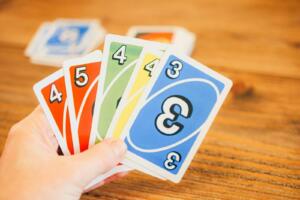
Table of Contents
Uno is a juggernaut of a card game, and it sits right alongside the likes of poker and solitaire as one of the most iconic card games ever. Although the original design first appeared over half a century ago, the game has sold millions of copies, spawned countless subdivisions and continues to create a committed audience base.
Uno involves strategy, chaos and luck; the trifecta of an enthralling game. It has been able to combine these to create a card game that has spanned international borders and continues to attract an audience, so there’s a fair argument that it’s the one game that’s been able to combine these factors most successfully.
Card games that carry a monetary risk, such as blackjack and poker, are some of the more commonly played games that people generally think of when card games that involve luck, strategy and chaos come to mind. In fact, we could apply this to the entire catalog of casino games, such as roulette and bingo. There isn’t as much chaos in a game of bingo or strategy, but it involves a considerable amount of luck.
Dissecting the chaos of Uno
Chaos, strategy and luck are all essential factors that have helped Uno cement itself as one of the most popular card games of all time. The game has widespread appeal and is popular with many demographics.
By fusing easy gaming rules and rapid, quick-fire rounds, Uno can be played by various generations and even people who speak different languages. While poker and other card games are the same, they require much more strategy. Often, simplicity is the best formula, which is what Uno has shown us time and time again as it continues to attract new players.
If we break down each element, we can interchange the word “chaos” with “drama” — and who doesn’t love a bit of drama when playing a game against their family and friends? Even 52 years after its original launch, the chaos of the game makes it exhilarating. A significant part of this stems from the quick gameplay and the fact that the game can change so rapidly.
Exploring the strategic element
While Uno doesn’t have the intrinsic, deep-rooted strategic element that poker has, it’s a different type of card game that aims to appeal to a different demographic and audience. Although there are multiple ways to utilize the reverse card, there are strategies in the game that might not be evident to the beginner.
A favorite strategy employed by many is to use the wild card to throw people off.
By using the wild card to change the color as often as possible, it’s possible to force the hand of those with a significant amount of one color. Other popular strategies include playing with a poker face, bluffing through the game and adopting an “honest” strategy before turning the tide when it gets into the thick of the action.
It’s a dog-eat-dog game in the world of Uno and other players around the table will be looking to push back against your strategy to try and succeed. It’s within this hurricane of chaos and strategy that the main elixir emerges that makes the game such an enticing proposition.
Counting your lucky stars
Of course, having the best strategy in the world and thriving in the eye of the chaos storm may not even secure the win when it comes to a game of Uno. A large amount of luck is involved, an element that can’t be influenced regardless of skill and experience.
The cards are randomly drawn from the deck and much like poker and blackjack, a lot of how the game plays out comes down to how the cards fall from that initial deal. While Uno doesn’t carry the same monetary risk as casino games, a large part of the game revolves around luck. So, if anybody says they have a surefire strategy for winning, they are lying!
Final thoughts
By combining each of the three sections discussed today, it’s easy to understand the broader picture of why Uno is a perfect blend of luck, strategy and chaos. Some may argue it’s a pinch more of luck and chaos than real strategy, but depending on the opponent and their playstyle, it’s possible to create tactics on the fly and gain the upper hand.



